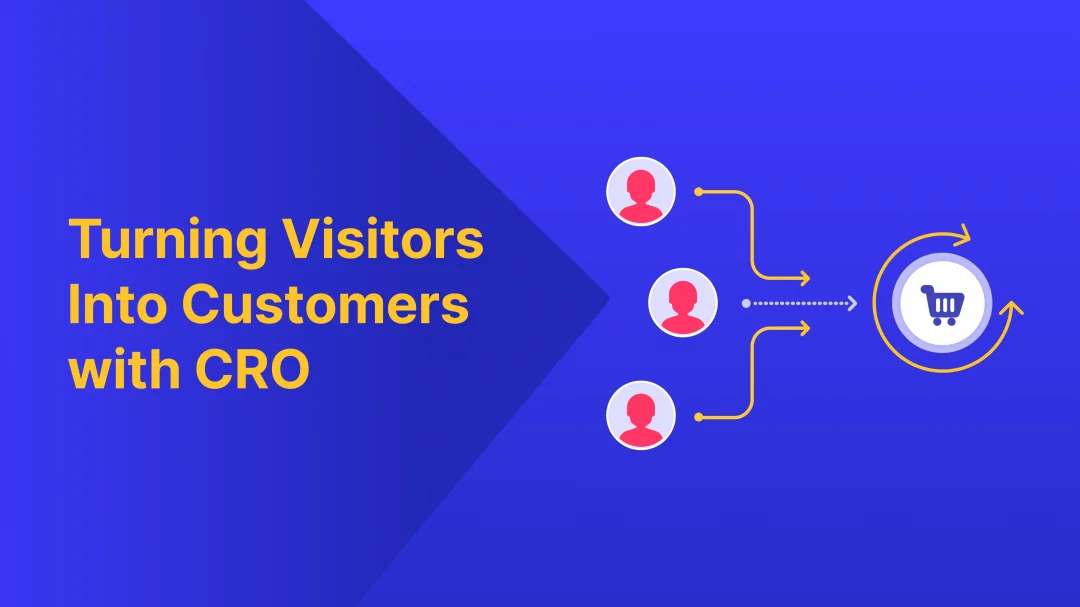In today’s digital landscape, the confluence of user experience (UX) and conversion rate optimization (CRO) is not merely beneficial; it’s essential. Companies are increasingly recognizing that to convert visitors into customers, they must deliver not just a functional but an enjoyable experience. This article explores how effective UX can dramatically influence CRO, and why the integration of strategic design elements with data-driven decision-making stands as a powerful tool for digital product success.
Understanding Conversion Rate Optimization
What is Conversion Rate Optimization?
Conversion Rate Optimization is a systematic process aimed at increasing the percentage of visitors who take a desired action on a digital platform. This could be anything from clicking on CTA buttons, and signing up for newsletters to purchasing a product. The ultimate aim is to transform your website’s visitors into customers by enhancing the user journey and ensuring that every interaction in the conversion path is optimized for success.
Why is Conversion Rate Optimization important?
In the digital marketing world, CRO is a powerful tool that directly impacts a company’s bottom line by improving the average conversion rate. By optimizing your website for conversions, you ensure that you are not just attracting traffic but that this traffic is more likely to convert into paying customers. Effective CRO leads to better customer experiences, increased revenue, and a lower bounce rate, making it a critical element of any successful online presence.

The User Experience and Conversion Rates
The Relationship between User Experience and Conversion Rates
User experience (UX) plays a crucial role in CRO. A positive user experience smooths the conversion process, leading to an increase in conversions. The design elements of your website, including its visual design, usability, and content structure, significantly impact user engagement and satisfaction. A well-crafted UX design fosters an enjoyable experience for users, encouraging them to engage more deeply with the content and take desired actions.
How User Experience Impacts Conversion Rates
The impact of UX on conversion rates can be profound. Websites that offer an intuitive and seamless journey typically see higher conversion rates. For instance, simplifying the checkout process on e-commerce websites can drastically reduce cart abandonment rates and increase sales. Similarly, optimizing the mobile experience can enhance mobile conversions, which is critical given the growing reliance on smartphones for internet access.
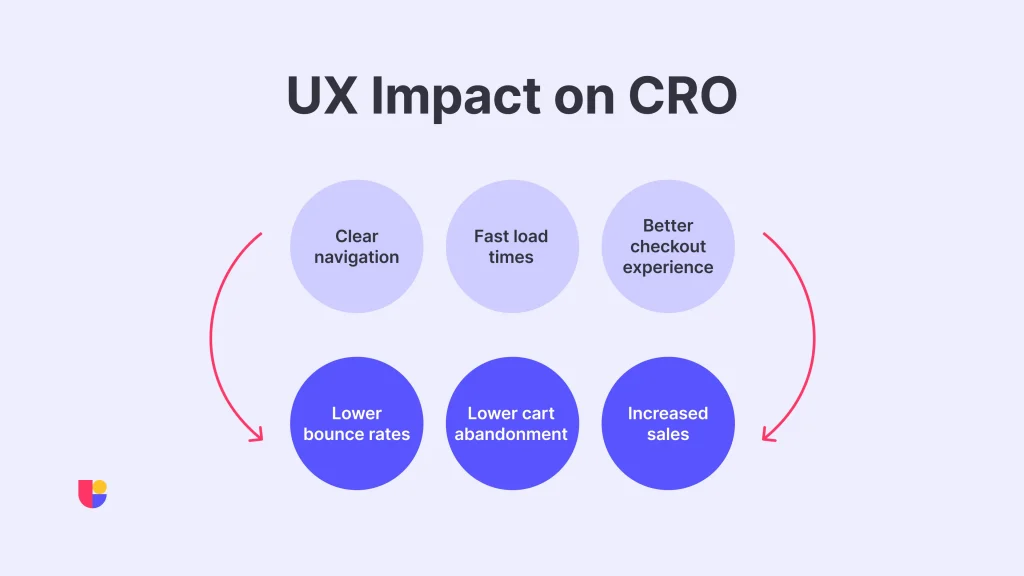
Key Elements of User Experience in Conversion Rate Optimization
User Interface Design and its Influence on Conversion Rates
The user interface (UI) design is a critical element of UX that directly influences conversion rates. An intuitive, aesthetically pleasing UI that aligns with user expectations can significantly decrease the percentage of users who leave the site (bounce rate) and increase the percentage of users who convert. Key aspects of UI design include clear navigation, visually appealing product descriptions, and optimized CTA buttons that are easy to locate and prompt users to take action.
Usability Testing and User Feedback for Improving Conversion Rates
Usability testing is an invaluable part of the UX process. By conducting usability tests and gathering user feedback, companies can gain valuable insights into how real users interact with their site. This ongoing process helps identify and rectify usability issues that could otherwise lead to frustration and decreased user satisfaction. Additionally, leveraging customer feedback to make design improvements is a data-driven approach that helps refine the user experience continuously.
The Role of User Behavior and User Journeys in Conversion Rate Optimization
Understanding user behavior and individual user journeys helps pinpoint critical areas where conversions drop off and identify potential opportunities for enhancement. Mapping out user journey paths allows designers and marketers to create a more tailored experience that guides users through the conversion funnel with greater precision.
The Impact of Mobile Users on Conversion Rates
With an ever-increasing number of users accessing websites via mobile devices, optimizing the mobile experience is no longer optional but a necessity. Mobile usability issues can significantly affect your site’s performance, leading to a lower conversion rate on mobile platforms. Ensuring that your website is mobile-friendly, with responsive design elements and easy navigation, is essential for capturing and converting this growing user base.
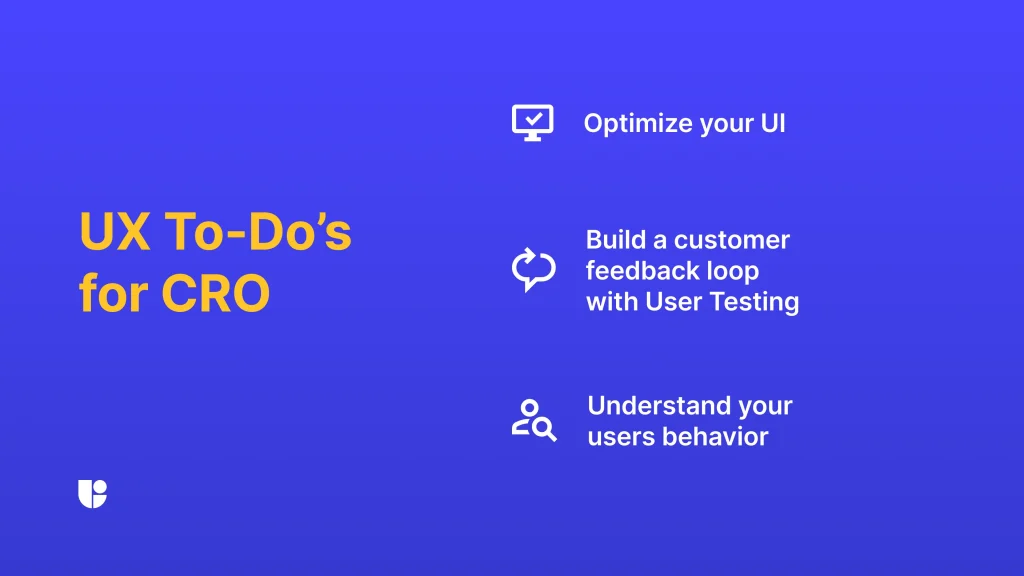
Strategies for Conversion Rate Optimization
The Conversion Funnel: Understanding the User Journey
A detailed understanding of the conversion funnel is essential for an effective CRO. This involves examining the stages from initial contact through various points of engagement to the final conversion. Each stage in the sales funnel should be optimized to guide the user toward making a purchase or completing the action desired. This includes ensuring that product descriptions are clear, engaging, and aligned with user expectations and that navigation aids rather than impedes the user journey.
Conducting Usability Tests and User Surveys
Regular usability tests and user surveys are critical for obtaining actionable insights that can guide UX improvements. These tools help identify common usability issues that may not be apparent to designers and developers but are frustrating for users. By continually gathering customer feedback and integrating this data into the design process, businesses can maintain a user-centric approach to website design that is crucial for CRO.
Leveraging Google Analytics for Conversion Rate Optimization
Google Analytics is a powerful tool for monitoring and analyzing website performance. It can provide detailed insights into user behavior, such as which pages have the highest bounce rates or what percentage of visitors leave after viewing only one page. These insights allow businesses to make informed decisions about where to focus their CRO efforts, such as optimizing specific parts of the user journey that are critical for maintaining engagement.
Implementing Multivariate and Split Testing for Optimization
Multivariate and split testing are invaluable for understanding how different elements of your website perform. By testing variations in design, content, and user pathways, companies can discern what works best for converting visitors into customers. This data-driven approach ensures that every change is justified by its impact on conversion rates, making it a cornerstone of successful CRO strategies.
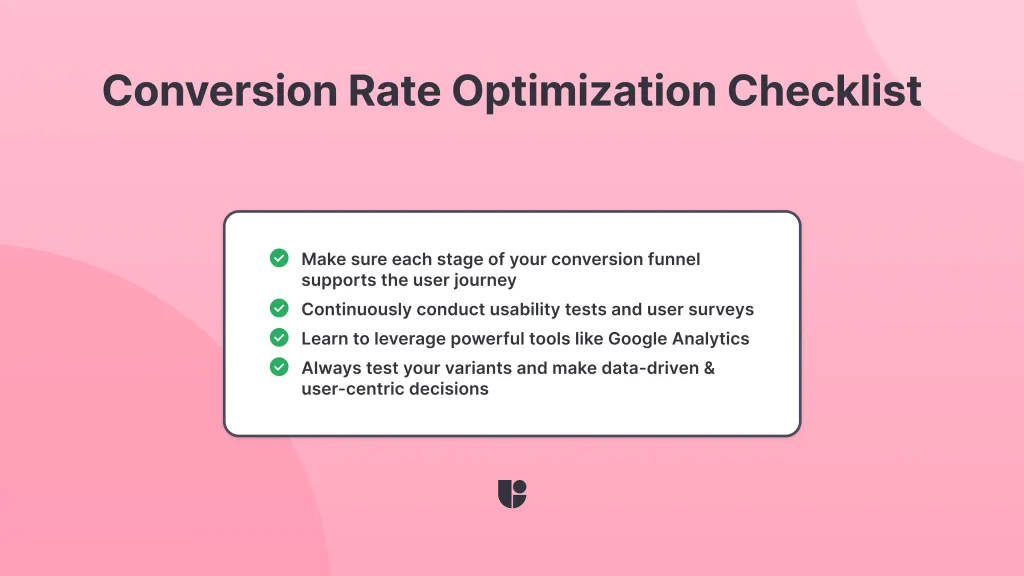
The Role of Design and Development Teams in Conversion Rate Optimization
Collaboration between design and development teams is vital for implementing effective CRO strategies. These teams must work together to ensure that design improvements not only look good but also function seamlessly across all platforms and devices. This collaboration is especially important in ecommerce websites where the buying process needs to be as straightforward and frictionless as possible.
Collaboration Between Design and Marketing Teams for Effective Optimization
The marketing and design teams should also work closely to ensure that the marketing campaign’s messaging is reflected in the website’s design and that both are geared toward a common goal: maximizing conversions. This includes aligning the digital product’s features with what is advertised and ensuring that the user experience leads seamlessly from initial interest to conversion.
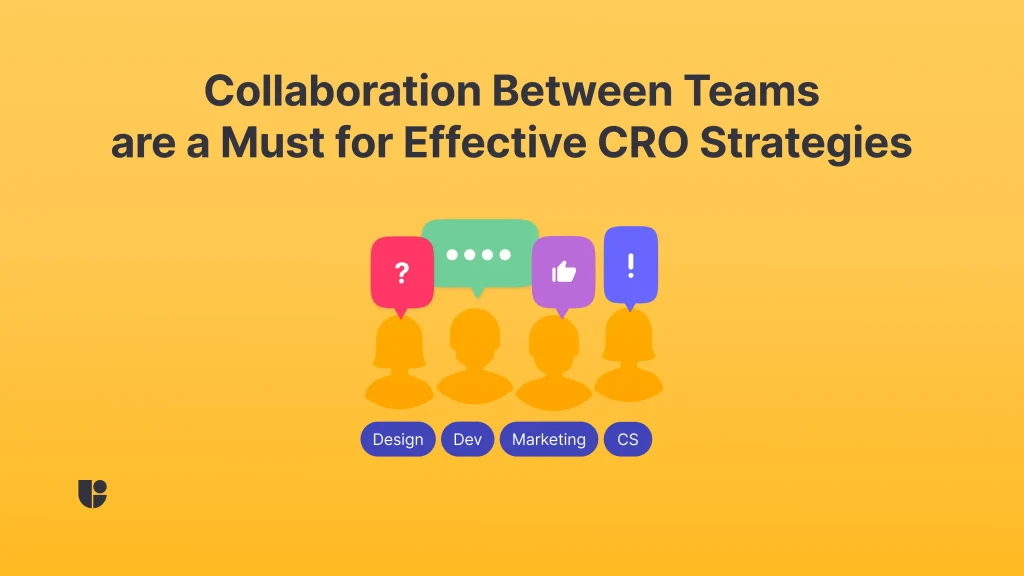
Usability Issues and Design Improvements for Increasing Conversion Rates
The Role of Data-Driven Approaches in Conversion Rate Optimization
The marketing and design teams should also work closely to ensure that the marketing campaign’s messaging is reflected in the website’s design and that both are geared toward a common goal: maximizing conversions. This includes aligning the digital product’s features with what is advertised and ensuring that the user experience leads seamlessly from initial interest to conversion.
Maximizing Conversion Rates: Tips and Best Practices
To maximize conversion rates, focus on optimizing key elements that enhance user engagement and satisfaction. This includes refining CTA buttons to make them more compelling, ensuring that the menu layout is intuitive, and leveraging customer reviews and testimonials to build trust and influence purchasing decisions.
Improving Calls to Action (CTAs) for Higher Conversion Rates
CTAs are one of the most critical elements in CRO. Effective CTAs should be visually striking, compelling, and clearly communicate the value of clicking through. They should be placed strategically across the website to guide users naturally through their journey toward conversion.
Leveraging Key Performance Indicators (KPIs) to Measure Success
Identifying and measuring the right KPIs is crucial for a successful CRO. These might include the conversion rate, the average time on site, the bounce rate, and the number of user interactions per visit. Tracking these indicators over time provides valuable insights into the effectiveness of different CRO strategies and where further optimizations are needed.
Optimizing Menu Layouts and Navigation for Better User Experience
Simplifying menu layouts and navigation can significantly enhance the user experience by making it easier for visitors to find what they’re looking for. A well-organized website with a clear, user-friendly navigation structure is more likely to keep users engaged and encourage them to complete the conversion process.
The Influence of Digital Experiences and Customer Testimonials on Conversion Rates
Digital experiences and customer testimonials are vital in establishing trust and credibility with potential customers. Highlighting positive reviews and customer stories can significantly influence new users’ decision-making processes, enhancing the likelihood of conversion. Integrating these elements into the user journey not only supports the marketing claims but also personalizes the experience, making it resonate more with visitors.
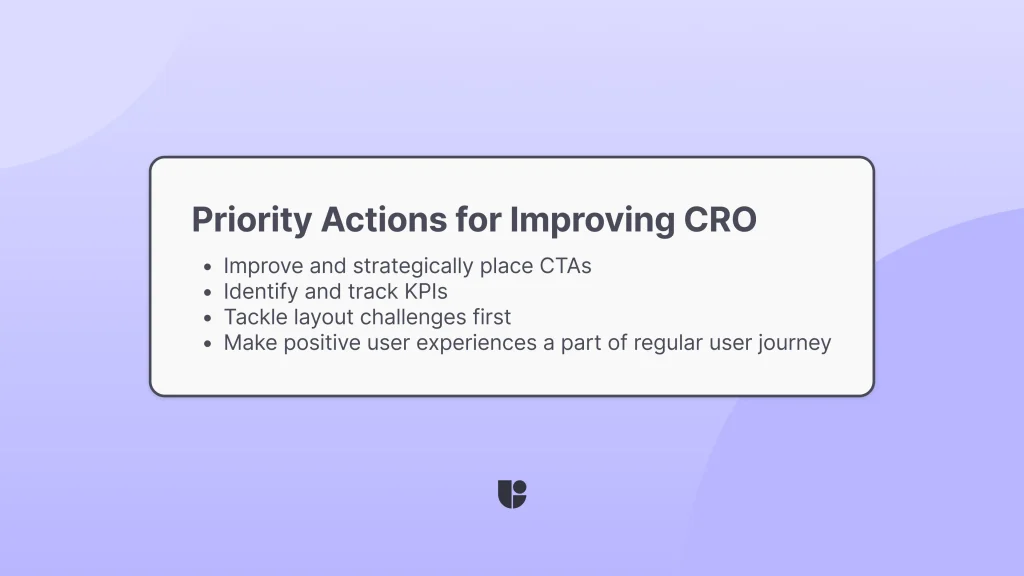
Tools and Techniques for Conversion Rate Optimization
Analyzing Form Analytics for Improved Conversions
Form analytics play a significant role in understanding how users interact with forms on your website. Analyzing data like form abandonment rates, the average time spent on each field, and which fields are most commonly left blank can provide crucial insights. These insights can help streamline form processes, reducing user frustration, and increasing the completion rate, which directly impacts conversions.
Leveraging Heatmaps and Visitor Recordings for Deep User Insights
Heatmaps are an excellent tool for visually understanding user behavior on your site. By showing where users click, scroll, and linger, heatmaps offer a unique view of how your site is used, revealing both strengths and areas for improvement. Similarly, visitor recordings provide a replay of the user’s journey through your site, offering a narrative context to their interactions. Both tools are invaluable for uncovering hidden issues that may not be apparent through traditional analytics.
Using Analytics and Testing Tools for Data-Driven Optimization
Advanced analytics tools such as Google Optimize or multivariate testing platforms enable businesses to conduct experiments with statistical significance. These tools can test variations across multiple dimensions of the website—from the visual design elements to the backend functionality—ensuring that every aspect of the user experience is optimized for both engagement and conversion.
Conclusion: The Ongoing Journey of CRO and UX Collaboration
Conversion rate optimization is not a one-time task but an ongoing process that demands continual refinement and testing. The most successful CRO strategies are those that are iterative, allowing for incremental improvements based on user feedback, behavioral data, and emerging trends in UX design.
The Importance of Continuous Improvement
Regular updates and refinements are essential to keep up with the evolving expectations of users and technological advancements. This ongoing process helps ensure that the website remains relevant, engaging, and capable of converting visitors into customers. It involves a cycle of testing, feedback, and redesign that keeps the user experience fresh and effective.
Emphasizing Collaboration for Optimal Results
The collaboration between UX designers, developers, marketers, and the product development team is vital for a holistic approach to CRO. Each team brings a different perspective that can lead to innovative solutions that drive higher conversions. This collaborative effort ensures that the user experience is seamless across all touchpoints and that marketing campaigns are fully integrated with the website functionality.
Driving Business Success Through Enhanced UX and CRO
Ultimately, the goal of merging UX with CRO is to not only increase the percentage of conversions but to create a positive and memorable experience that encourages repeat business and customer loyalty. By focusing on creating a seamless journey for users—from their first interaction with the online presence to the final conversion—businesses can achieve not just short-term gains but long-term growth.
With the right strategies, tools, and a commitment to ongoing improvement, businesses can effectively transform their digital platforms into high-performing engines that consistently turn browsers into buyers.


